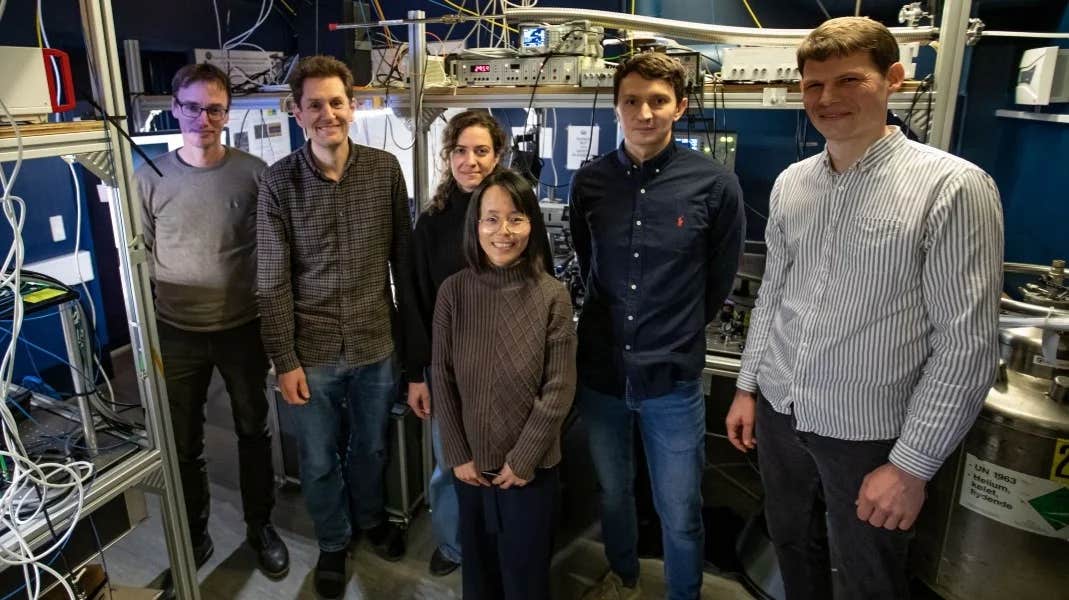Danish quantum physicists make monumental discovery
In a new breakthrough, researchers have solved a quantum physics problem that has caused quantum researchers headaches for years.

Part of the team behind the invention. From left: Peter Lodahl, Anders Sørensen, Vasiliki Angelopoulou, Ying Wang, Alexey Tiranov, Cornelis van Diepen. (CREDIT: Ola J. Joensen)
In a significant breakthrough, researchers at the University of Copenhagen, working with Ruhr University Bochum, have solved a persistent issue in quantum research. They can now control two quantum light sources instead of just one.
While this might seem trivial to those unfamiliar with quantum mechanics, it's a monumental step forward. This advancement allows the creation of quantum mechanical entanglement, a phenomenon that holds immense potential for commercial technology applications.
Controlling two quantum light sources is crucial in quantum physics. Researchers worldwide have long sought to develop stable quantum light sources and achieve entanglement—a phenomenon with almost sci-fi properties where two light sources can instantly affect each other, even over large distances. Entanglement forms the basis of quantum networks and is central to developing efficient quantum computers.
Researchers from the Niels Bohr Institute recently published their findings in the journal Science. According to Professor Peter Lodahl, a key researcher in this project, this is a critical step toward advancing quantum technology and "quantizing" computers, encryption, and the internet.
"We can now control two quantum light sources and connect them. It might not sound like much, but it’s a major advancement and builds upon the past 20 years of work. By doing so, we’ve revealed the key to scaling up the technology, which is crucial for the most groundbreaking of quantum hardware applications," says Professor Lodahl, who has been researching in this area since 2001.
Related Stories
This innovation happens on a nanochip, barely larger than a human hair, developed by the researchers over recent years.
Professor Lodahl's group focuses on quantum technology using photons, light particles, to transport quantum information. Despite being a leader in this field, they could only control one light source at a time until now due to the sensitivity of these sources to external noise. The new research has succeeded in creating two identical quantum light sources.
"Entanglement means that by controlling one light source, you immediately affect the other. This makes it possible to create a whole network of entangled quantum light sources, all of which interact with one another, and which you can get to perform quantum bit operations in the same way as bits in a regular computer, only much more powerfully," explains postdoc Alexey Tiranov, the lead author of the article.
A quantum bit can be both a 1 and 0 simultaneously, leading to processing power far beyond today's computer technology. According to Professor Lodahl, 100 photons from a single quantum light source contain more information than the world's largest supercomputer can process.
Using 20-30 entangled quantum light sources could potentially build a universal error-corrected quantum computer—the ultimate "holy grail" of quantum technology. Large IT companies are investing billions in this pursuit.
The biggest challenge was moving from controlling one to two quantum light sources, which required developing extremely quiet nanochips and precise control over each light source. Now, with this breakthrough, the fundamental quantum physics research is established. The task now is for other entities to build upon this work and apply quantum physics to technologies like computers, the internet, and encryption.
"It is too expensive for a university to build a setup where we control 15-20 quantum light sources. So, now that we have contributed to understanding the fundamental quantum physics and taken the first step along the way, scaling up further is very much a technological task," says Professor Lodahl.
The research was conducted at the Danish National Research Foundation's "Center of Excellence for Hybrid Quantum Networks (Hy-Q)" and is a collaboration between Ruhr University Bochum in Germany and the University of Copenhagen’s Niels Bohr Institute.
Note: Materials provided above by the The Brighter Side of News. Content may be edited for style and length.
Like these kind of feel good stories? Get the Brighter Side of News' newsletter.
Joseph Shavit
Head Science News Writer | Communicating Innovation & Discovery
Based in Los Angeles, Joseph Shavit is an accomplished science journalist, head science news writer and co-founder at The Brighter Side of News, where he translates cutting-edge discoveries into compelling stories for a broad audience. With a strong background spanning science, business, product management, media leadership, and entrepreneurship, Joseph brings a unique perspective to science communication. His expertise allows him to uncover the intersection of technological advancements and market potential, shedding light on how groundbreaking research evolves into transformative products and industries.



